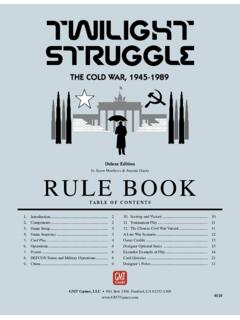Transcription of PLAYBOOK - gmtgames.com
1 Designer: Salvatore Vasta Developer: Mark Dey Lead Tester: Allen HillPLAYB O O Introduction .. Alternate Learning Methods .. Scenario General Information .. Scenario Standard Set Up .. Basic Set Up .. Set Up Table Terms .. Two-Faction scenarios .. Poland 1939 .. Scandinavia 1940 .. France 1940 .. Balkans 1941 .. Mediterranean 1940-1942 .. French North Africa 1942-1943 .. France 1944 .. USSR USSR 1941-1944 .. Soviet vs. Western 1945-1946 .. 22 Table of Three-Faction scenarios .. Main Event 1939-194? .. Europe 1941-1945 .. Europe 1942-1945 .. 32 Dedications .. Europe 1943-1945 .. Europe 1944-1945 .. Germany 1945 .. Rules Notes .. Rules to Avoid Getting Wrong .. Pro-[Faction] Marker Related Events .. Tactical Tips .. Play-By-Email Adjustments.
2 Solitaire Play Adjustments .. Laws of Gaming .. Designer s Notes .. Bibliography .. Event Marker Quick Reference .. 51 Credits .. 52 GMT Games, LLC Box 1308, Hanford, CA Surrender ~ Playbook2 2014 GMT Games, IntroductionIn addition to the scenarios , the PLAYBOOK contains other sections dealing with how to learn the game, such as rules notes, tactical tips, and more designer notes. See the Table of : Whether you have already read the rulebook or are using one of the alternate methods below, before setting up a scenario read section It explains those aspects of scenario set up that are consistent with each scenario, such as how to read a Set Up Alternate Learning MethodsThe following are alternate methods of learning the game as op-posed to reading the Rulebook from cover to cover.
3 Each method will list specific rules to read under the header Rules to Read . Unless otherwise restricted, read the numbered rule and all lower-level rules within that section. Example: If rule is listed, read and you are reading a rule, do not become worried if it refer-ences another rule or concept you have not covered yet. You will learn about it eventually. Sequence of Play Method ( ): This is for those that want to read all the rules, but mainly in the order they may be encountered in the Sequence of Play. This method is supported by the Flowcharts which contain rules number references within the listed game mechanic to perform. Training scenarios Method ( ): This provides a way to learn the game in small steps while playing out several scenarios . They will not cover all the rules in the game, but do provide a foundation of its core mechanics.
4 After you are done with the training scenarios , read the remaining rules. Sequence of Play MethodLearning Objective: Learn in the order in which a turn is played. Initially focus on the economic system, the integrated movement and combat system, and the supply system. Worry first about how to move, fight, and stay supplied. The rest will come while playing out Up: Set up and play the Main Event scenario ( ) with the following changes. As per each faction s Set Up Table, set up counters that either have no Entry-H date or an Entry-H date of Dec-40 or earlier. At the end of the Dec-40 turn, either stop and set up the scenario again; or continue playing by setting up counters that have an Entry-H date from Jan-41 to Dec-41 (and so forth after Dec-41). The Axis faction must perform the scenario s Special Rule: Setting the Stage to Read: Game Basics: 1; 2; 3; 5 to Weather Phase: 11 Declare War Phase: Economy Phase: 9 to Strategic Warfare Phase: , Strategic Movement Phase: 4 to Actions Sub-Phase: , to , 6 Supply Check Sub-Phase: 7 to No Supply Phase: Replacements Phase: Upgrade Phase: Mobilization Phase: Diplomacy Phase: Victory Check Phase: End of Turn Phase: Scenario Related: , 13 Marker Related: 14, Training scenarios MethodPlay each of the training scenarios in the order listed.
5 These scenarios are generally one-sided affairs in favor of the Axis faction, but the main point is to learn how to to Read: Before playing the training scenarios , read the following rule sections. Game Basics: 1; 2; 3; and 5 to Do not read: to ; ; ; and Surrender ~ Playbook3 2014 GMT Games, Training Scenario OneThis scenario covers the invasion of Poland. Its rules deal with basic air and ground operations. Learning Objective: Learn about air and ground unit actions, Mobile ground attack, Conditional Events, and Event markers. While you read and play, focus on the following. The integrated movement and combat system: an important element of this is the effect an EZOC has on a ground unit as it is moving and attacking. The basic concept is that except for a ground unit s initial move, if it finds itself in an EZOC, it must either end its activation or attack an adjacent enemy ground unit.
6 Any type of ground unit can perform a Mobile attack ( ) and as long as it has enough movement points available, the same unit can attack more than once in a turn. One air unit may provide Air Support ( ) to a ground combat. This is declared during the ground attack, not before. An air unit cannot directly attack an enemy ground Up: Set up and play the Poland 1939 scenario ( ). Rules to Read: Operational Movement for air and ground: , to Ground Combat: not read: , and ignore any part of a rule related to an As-sault combat or a fort . In section , only read Isolated . For the following, read only the specific numbered sections. Do not read their lower-level rules. Actions: 6; ; ; ; , and Ignore references to production points; assume enough exist for all purposes. Conditional Events: 13 and Event Markers: 14 and Surrender ~ Playbook4 2014 GMT Games, Training Scenario TwoThis scenario covers the invasion of Denmark and Norway.
7 Its rules deal with weather, airdrop, and amphibious Objective: Learn about weather, Airdrop and naval unit Actions, ground combat Assault attack, amphibious invasion, and Event markers. While you read and play, focus on the following. See how Poor or Severe weather impacts movement and combat. If you play the scenario and both turns are Fair weather, play it more times, but with the weather as Poor and Severe. An Airdrop marker is put on the map as a separate Action ( ) and it must be within range of a friendly air unit. Related to this are how Actions can be performed in any order. Example: In this scenario, the Axis faction wants to put the Germany Airdrop marker in Oslo before invading it. To do this, the 5 Luf air unit must be in Aalborg (hex 1923) because the Airdrop marker has to put within three hexes of a friendly air unit.
8 Therefore, the Axis faction first activates the 18 Army to perform an Army Operations Action ( ) to attack and clear the way in Denmark. It then activates the 5 Luf to perform an Air Rebase Action ( ) to move to Aalborg. It then performs the Airdrop Action to put the Airdrop marker in Oslo. Finally, it ac-tivates the Nor army to perform an Amphibious Invasion Action. Using a Surface Action marker as a warship unit for the Naval Escort Action ( ) in order to receive the ground combat Naval Support DRM ( Amphibious Invasion Assault). Walking through the Amphibious Invasion ( ) process. This rule is long, but follows a fairly sequential order. Do not worry about memorizing it. This is to experience how it works. You can review the process again later when playing other scenarios .
9 So why are you trying this now? An amphibious invasion may be possible in Training Scenario Three and this provides an opportunity to practice it without worrying about Up: Set up and play the Scandinavia 1940 sce-nario ( ). Rules to Read: Ground Combat: and Note the references to a fort . You will not encounter a fort in this scenario, but you will in Training Scenario Three. Actions: to ; Ignore references to tracing a naval movement path; assume it exists. Weather: 11 Turn Completion: 12 For the following, read only the specific numbered sections. Do not read their lower-level rules. Actions: and Conditional Events: up to and including Step 1. Event Markers: ; ; Surrender ~ Playbook5 2014 GMT Games, Training Scenario ThreeThis scenario covers the invasion of the Low Countries and France.
10 It adds many more rules, dealing mainly with economy, air and naval operations, and logistics. Take your time. Play the scenario several times. When done, you will have learned many of the game s core Objective: Learn about the economic system, strategic combat, air/naval combat, strategic movement, naval unit actions, unit replacements and mobilization, supply, forts, and policies. While you read and play, focus on the following. National Will ( ) tracks a country s willingness to keep fighting. The need for production points to activate ground units ( ) and perform Replacements ( ). Additional Actions available to air and naval units, such as the ability of an air unit to directly attack another air or naval unit. Tracing a supply line, especially across a Sea Zone ( ) and the need for a convoy unit to be in the same area as the unit using it for supply purposes.









